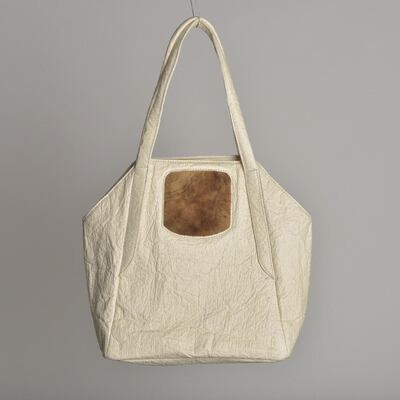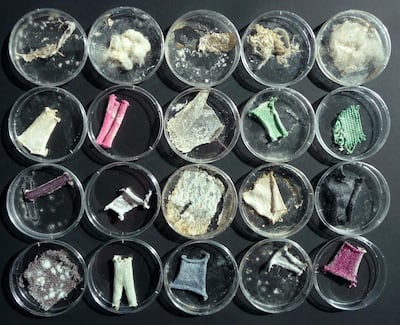The production of leather and textiles is, generally speaking, a resource-heavy process. There are, of course, hugely diverse impacts, whether human, animal or ecological, dependent upon material type and production methods. But the growth in popularity of vegan lifestyle choices, as well as an increased concern for animal welfare in livestock farming, has resulted in a growing number of innovative material developments as an alternative to animal skins. Leather substitutes are now being grown in the lab, instead of on the back of an animal. Fashion is entering a brave new world.
Some particularly innovative responses have been developed in an effort to offer alternatives. One of these is mycelium leather, or muskin. Made from fungus spores, the material mimics animal leather, with crisscrossing spores that are grown into a predetermined shape and size, thereby eliminating waste. The material is processed similarly to animal leather, only without the toxic chemicals, and is entirely biodegradable. The process generates an exceptionally soft material that is thick, strong and suede-like in texture. Muskin is also being used for interior design, as well as for packaging.

Officina Corpuscoli is an Amsterdam-based multi-disciplinary studio that works on thought-provoking solutions and design outcomes that reflect on contemporary material culture, often by working with living organisms. The company focuses on the industrial scale-up of mycelium-based materials. One such project is Caskia, otherwise known as 'Growing a Mars Boot', which was commissioned by the Museum of Modern Art (MoMA) as part of its Items: Is Fashion Modern? exhibition. Caskia explores the restrictions that characterise space travel and the need to optimise logistics. In this case, fungal mycelium spores are ideal because they minimise the volume of matter loaded onto the craft at launch, but can then be cultivated to create a plethora of materials and tools during the journey.

Another material made from an ‘animal’ byproduct is spider silk. The silk produced by spiders to spin webs has remarkable properties that include high tensile strength, elasticity, durability and softness. US company Bolt Threads produces a synthetic spider silk, thereby avoiding the difficult process of extracting it from a spider. It harnesses proteins found in nature to create textiles with similar capabilities, through a fermentation process using yeast, sugar and water, then spins the silk protein into fibres. Like most materials grown in the lab, it can be programmed to deliver specific qualities far more varied than those available in nature.
A ground-breaking figure in lab-grown materials is Suzanne Lee. A former research fellow at Central Saint Martin's, and author of Fashioning the Future: Tomorrow's Wardrobe, Lee is now the creative director of Modern Meadow, as well as the founder of Biofabricate, an annual conference on bio engineered materials. Lee produced a range of jackets and shoes under the name BioCouture in early 2000, from a bio material with similar properties to leather. The material was produced through a fermentation process made from a mixture of kombucha tea, sugar and heat. Lee believes that microbes are "the factories of the future".
Modern Meadow, a Brooklyn-based company, is harnessing the collective power of design, biology and engineering to biofabricate new materials. It focuses on using living cells to grow nature’s materials. Modern Meadow believes in a future where animal products are animal-free. It envisions creating a world of biofabricated materials that provide infinite design possibilities, at scale. It already makes a bioleather called Zoa by optimising cell engineered collagen. “We’re excited to create a whole new landscape of bioleather materials that has never before been possible," says Lee.
From algae and bacteria to mushrooms and yeast, architecture to apparel, personal care and performance, Biofabricate showcases how biotechnology is facilitating a new material revolution. The conference presents the latest disruptive research and highlights companies that are growing the materials of the future. It brings together a unique audience of designers, scientists, artists, engineers, global brands, startups, investors, policy makers, trend forecasters and media. Founded in 2014 by Lee, the aim of the conference is to nurture collaboration, share knowledge, build community and accelerate innovation.
Lee and others see living organisms as the future of clothing and textiles - organisms that have a symbiotic relationship to the body, or living materials that can diagnose disease, treat and nourish us, as well as enhance our wellbeing. This is something Phillips FutureLab foresaw years ago, predicting the emergence of microbes that clean your body, then weave your clothing around you each day. The future of clothing and textiles is an exciting one - a biological, electronic and designed one. One that establishes clothing as a meaningful and valuable part of our life, with capabilities far beyond simply covering our body.
_____________
More from Sass Brown:
[ The delicate art of cultural appropriation ]
[ Eliminating fashion waste from the source ]
_____________





